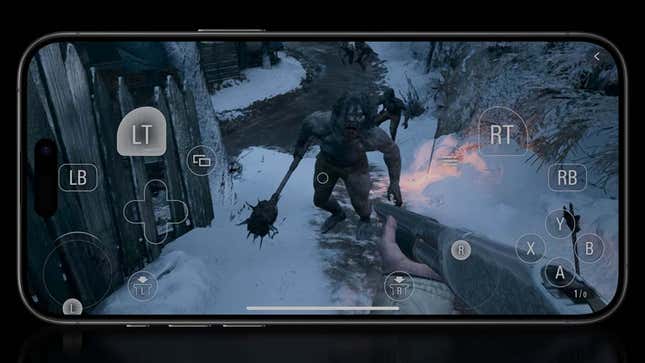
The fact that you can, today, play Capcom’s Resident Evil Village natively on an Apple iPhone is undeniably impressive. But actually trying to play this popular horror game on Apple’s latest pocketable device doesn’t make for a great experience.
In September, Apple announced plans to bring a few big console and PC games—like Resident Evil Village and Assassin’s Creed Mirage—to its most powerful mobile devices, including the new iPhone 15 Pro and 15 Pro Max. In another example of Apple trying to convince players and developers that its devices are perfect platforms for gaming, the tech giant promises its new hardware will allow you to play big games anywhere on your iPhone.
Now the first of these big iPhone ports is here, with Resident Evil Village launching today on the iOS app store. I’ve been playing the game ahead of today’s release on a iPhone 15 Pro that Apple sent to us to put Village through its paces. After a few hours of survival horror and hand torture I’m not convinced I’d want to play big games like this on a phone just yet.
First released on consoles and PC in 2021, Resident Evil Village is bit of an odd choice for the first big AAA game to be championed in Apple’s new gaming push. But as someone who loved the original version on PS5, I was hardly upset to check it out again. However, this time I was playing Village on a phone. Strange.
Resident Evil Village on a phone starts off well enough
When I first started playing the game’s intro, I was impressed. I showed my wife and she was also blown away by a game like this running on a phone. Games on mobile devices have looked really good for a few years now, but Village is on a whole other level. It features incredible detail with high-resolution textures, realistic character models, and gorgeous (and spooky) lighting.
At first, in the small confined house that the game starts in, things felt fine. But the moment I got into the titular village, the game began to go off the rails.
Performance hopped around like a drunken frog. I’d feel the game slow to a crawl when lots of buildings or just a few enemies appeared onscreen. It got so bad that I checked out the game’s visual settings to see what I could change to help possibly improve performance. To my surprise I was greeted by the same quantity of sliders that I’d expect to find in a PC port. I was able to lower the quality of shadows, tinker with Apple’s DLSS-like MetalFX upscaling feature, and adjust model quality and depth of field options.
Oddly, I didn’t see a simpler, quick-fix option geared toward folks who might not be familiar with all these settings and just want to get the game running well on the iPhone 15 Pro’s specs. Even weirder, you can bump up the settings to a level that makes it run like a slideshow on this powerful phone. On the one hand, it’s nice that the game can scale into the future as Apple releases more powerful devices, but it also seems like a bad experience for folks just looking to play Resident Evil on their phone and who might be used to most mobile games just running fine without needing tweaks.
Sadly, even when I lowered the settings and put the game into what it referred to as a “performance mode,” I ran into constant slowdown that made it hard to enjoy Resident Evil Village. I also started to notice how the small screen made inventory management a pain, making it hard to parse what was happening in areas with lots of fine details and tiny objects.
You’ll need a controller and battery pack
Another thing to keep in mind: You need a controller to play Village on the iPhone 15 Pro. I mean, technically, you can play this horror sequel with touchscreen controls. But it’s almost unplayable like that, with all the buttons of an Xbox controller covering up the already crowded screen with not only more icons, but your pudgy fingers. And even if you don’t mind covering up the action with your fingers, actually fighting enemies with touchscreen controls is a nightmare.
Realistically you’ll need to lug around a controller of some kind to play Village on the iPhone, which is a much bigger hassle than just pulling out your phone would be. It also makes me wonder why I wouldn’t just bring my Switch or Steam Deck to play on to avoid burning up my phone’s battery.

Speaking of the iPhone 15 Pro’s battery, I was surprised to see it hold up pretty well. I was able to play about three hours on a full charge before the phone’s battery hit 20-ish percent. However, if this was your main phone, you’d likely not want to drain your all-important communication device so much without a charger nearby.
As I mentioned before, the fact that I can play all of Resident Evil Village on an iPhone is impressive, and when it works, it’s a much better experience than streaming a game to a phone. Unfortunately, the iPhone 15 Pro—while powerful—just doesn’t seem capable of running this game at a level I’d want.
That said, phones continue to grow in processing power every year and I think in two (or three) phone generations games like Village and Assassin’s Creed will run flawlessly on newer devices. For now, Resident Evil Village on an iPhone is more of a neat thing to show off to people, but not a good way to actually play it.
.